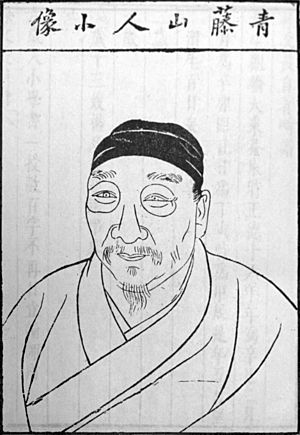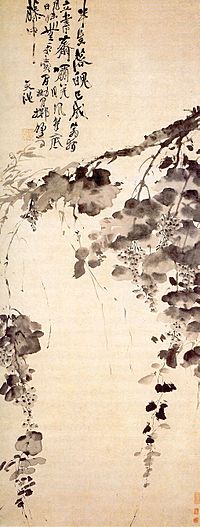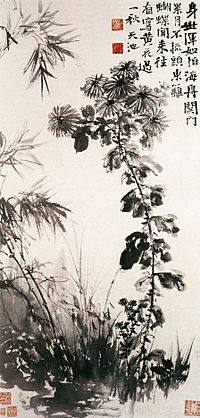Xu Wei facts for kids
Quick facts for kids
Xu Wei
|
|
|---|---|

Xu Wei, woodcut print from 1600
|
|
| Born | 1521 |
| Died | 1593 |
| Occupation | Painter, poet, playwright, calligrapher |
| Spouse(s) | Pan Si |
| Children | Xu Mei, Xu Du |
| Parent(s) | |
Xu Wei (Chinese: 徐渭; pinyin: Xú Wèi; Wade–Giles: Hsü Wei, 1521–1593), also known as Qingteng Shanren, was a famous Chinese artist during the Ming dynasty. He was a talented painter, playwright, poet, and even a tea master. Xu Wei was known for his amazing artistic expression.
His unique painting style was very new for his time. It influenced many later painters, like Bada Shanren and Qi Baishi. Qi Baishi once wrote a poem saying he wished he had lived 300 years earlier. He wanted to help Xu Wei by grinding his ink and preparing his paper. Many people think Xu Wei was the founder of modern painting in China. His influence is still strong today.
Contents
About Xu Wei's Life
Xu Wei had several different names he used throughout his life. His courtesy names were Wenqing and Wenchang. He also used pseudonyms like "The Mountain-man of the Heavenly Pond" and "Daoist of the Green Vine House."
Early Life and Education
Xu Wei was born in Shanyin, which is now Shaoxing in Zhejiang province. He was raised by his single mother, who passed away when he was 14 years old. At age 21, he married a woman named Pan, but she died five years later.
Xu Wei passed a local exam when he was 20. However, he tried eight times to pass the bigger provincial exams but never succeeded. Even so, he worked for Hu Zongxian. Hu Zongxian was a top commander who defended the coast against pirates called wokou.
Challenges and Later Years
After General Hu Zongxian was arrested, Xu Wei became very worried. He faced a difficult time in his life and was jailed for seven years. A friend named Zhang Yuanbian helped him get out of jail when Xu Wei was 53.
It is thought that Xu Wei might have had bipolar disorder. This was a condition that people in China recognized even back then. After being released, Xu Wei spent the rest of his life painting. He didn't earn much money from his art during his lifetime. However, his paintings are now very valuable and sought after.
Xu Wei's Creative Works
Xu Wei was a very talented writer and artist in many different areas.
Plays and Drama
Xu Wei was a playwright, meaning he wrote plays. One of his works was called Singing in Place of Screaming (simplified Chinese: 歌代啸; traditional Chinese: 歌代嘯; pinyin: gē dài xiào). He also wrote a guide about southern drama called Nanci Xulu (simplified Chinese: 南词叙录; traditional Chinese: 南詞叙錄; pinyin: Náncí Xùlù).
His most famous plays are a group of four plays known as Four Cries of a Gibbon (simplified Chinese: 四声猿; traditional Chinese: 四聲猿; pinyin: Sì Shēng Yuán). These plays include:
- The Mad Drummer Plays The Yuyang Triple Rolls (simplified Chinese: 狂鼓史渔阳三弄; traditional Chinese: 狂鼓史漁陽三弄; pinyin: Kuáng gǔ shǐ yú yángsān nòng) - This play tells about the actions of Cao Cao.
- Zen Master Yu Has a Dream of CuiXiang (simplified Chinese: 玉禅师翠乡一梦; traditional Chinese: 玉禅師翠鄉一夢; pinyin: Yù chánshī cuì xiāng yī mèng) - This is a story with Buddhist themes.
- The Female Mulan Joins the Army in Place of Her Father (simplified Chinese: 雌木兰替父从军; traditional Chinese: 雌木蘭替父從軍; pinyin: Cí mùlán tì fù cóngjūn) - This play is about the famous hero Hua Mulan.
- The Girl Graduate Rejects the Female Phoenix and Gains the Male Phoenix (simplified Chinese: 女状元辞凰得凤; traditional Chinese: 女狀元辭凰得鳳; pinyin: Nǚ zhuàngyuán cí huáng dé fèng) - This play tells the story of Huang Chonggu.
Many of Xu Wei's plays focused on women's stories and challenges. Because of this, some people see him as an early supporter of women's rights.
Poetry and Calligraphy
Xu Wei was also a well-known poet, writing in the shi style. His collected poems and writings are available in 30 chapters. A later writer named Yuan Hongdao added comments to his works. Yuan Hongdao and other writers of his time were definitely influenced by Xu Wei's writings.
Of all the arts Xu Wei practiced, he thought his calligraphy was his best skill. His poetry was the next art form he valued most highly.
Xu Wei's Painting Style

Today, Xu Wei is known as one of the first Chinese painters to use a special technique called "splattered ink." This method involves using a lot of ink, almost pouring it onto the painting surface. This created a very unique and expressive look in his artwork.
Images for kids




